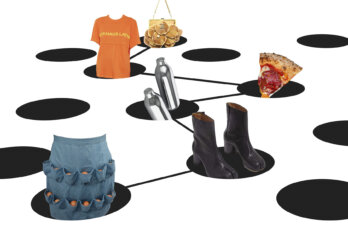In the title story of Instructions for the Drowning, Steven Heighton’s newest collection of short fiction, a man dives off a dock to save his wife, who has begun to flounder in the deep water of a cottage-ringed lake. Her panic slices violently through a languid day. But, when he reaches her, the husband finds his wife’s will to survive is just as violent, and he remembers his own father’s advice: to avoid being dragged under by a drowning swimmer, there is only one way to save both yourself and the victim—knock them out cold.
The narrator actually recalls the father’s instructions delivered in a more pointed way: “If you ever jumped into the water to help a drowning man, he would try to pull you down with him.” It’s the “try to” we keep returning to as we witness not only a near drowning but also the husband’s alarm that his wife would kill him to save herself. The marriage’s many disappointments bob to the surface as the couple swing their fists, both trying to stay afloat.
Every man in Instructions for the Drowning seems, in some way, to be drowning. Written—or at least originally published—between 2007 and 2022, the stories deal almost entirely with the inner lives of men. Women appear on the periphery as wives and daughters, but the real confrontations happen between father and son, doctor and patient, with strangers who appear and disappear with equal levels of threat, or with the man residing inside a character. It is a determinedly midlife book, one shaken and stirred by self-reckoning. Published posthumously, it is also Heighton’s last. Born in 1961, he died of cancer in the spring of last year, at the age of sixty.
By his own midlife, Heighton had become a writer’s writer (Annie Proulx, of The Shipping News and Brokeback Mountain fame, blurbed one of his books), but he was also assuredly a reader’s writer. From the appearance of his first book of poems, the award-winning Stalin’s Carnival in 1989, through to his first-album of songs, The Devil’s Share, released just a year before his death, it’s hard to think of a genre he did not touch. He was a poet, novelist, essayist, memoirist, songwriter, and short story writer. But, more than his impressive publication history, it is Heighton’s pressing engagement with the human experience that feels compelling. “Canada’s most romantic novelist,” the critic Donna Bailey Nurse called him, referring not to any lovelorn storylines but rather his “capital ‘R’ Romantic” obsession with the individual and imagination, with nature and our place in it. In the poem “A Cosmos,” from his collection The Waking Comes Late, a father and daughter wade into the sea at night: the daughter is fearless, the father anxious to hold her hand. Even in that moment of wonder, he is beset by the idea of losing her, or losing himself, or just of death, as he looks “beyond the coastal / shelf of the familial, to a solo / unmooring: all ties, all selves.”
Heighton cut an effortlessly cool figure: the sideburns, the leather jacket, the rakish-yet-dreamy stare. But, if his writing is any indication, that coolness hid a raw powerlessness—dread of the “solo unmooring.” In a memorial address for the Ontario poet Al Purdy, Heighton said “male writers are driven primarily by a fear and hatred of mortality.” Those feelings are stitched minutely, and deeply, into the cloth of these new stories. But there is something else here too: a sense not just of survival, lungs gasping for air, but of reaching out for connection, of grasping on and holding tight.
We won’t know what Heighton’s work would have looked like at sixty-eight or seventy-seven. We will never see how his stories might have changed in later life. However truthful the anxiety in this collection might feel, one can’t help but chafe against the possibility his legacy might now be forever defined by such themes. In Instructions for the Drowning, however, he uses his poet’s precision, his depth as a novelist, and his intimacy as a memoirist to give us a glimpse of the closure he may have hoped for—for himself, for his characters, and also for his readers.
In 2015, Heighton travelled to the Greek island of Lesvos. It was a snap decision: he wanted to see the refugee crisis up close, feeling some responsibility or duty to do so. He arrived with little knowledge of the language and even less training and found himself, according to his publisher, “thrown into emergency roles for which he was woefully unqualified.”
The experience inspired a 2020 memoir, Reaching Mithymna, but a similar existential helplessness roils throughout Instructions for the Drowning. The men in these stories are consumed with their place in a society that no longer feels built to fit them, and this leaves them looking for ways to control outcomes—and sometimes death. Questions appear surface level (Will she keep loving me? ) but really come down to the big midlife questions: Am I enough? Have I been enough? The words “masculine duty” appear twice: once in reference to the father who imparts the stern instructions for saving a drowning man and another time in reference to a car salesman who, after a mundane test drive turns dark when the protagonist’s daughter discovers a suicide, calmly persists. “He leans down and—as if gently reminding you of the masculine duty to push on with life’s errands in the face of misfortune murmurs, ‘Dare I ask, Nick, if you’ve made a decision about the Camry?’”
In his review of Heighton’s 2012 collection of short stories, The Dead Are More Visible, for the Toronto Star, critic and editor Alex Good signalled the recurring intrusion of “dangerous figures into an otherwise placid, everyday reality.” Here, too, the banal is continually interrupted by the dangerous, the surprising, the threat of the other. But that “other” generally comes in the form of another man. In “Expecting,” it’s a stranger. Leo Losco, former bullied child, finds his anxiety ramping up even as his life becomes happier. When his much-loved, pregnant wife discovers a lost wallet and passport, Losco, desperate to please her, sets about trying to return the items to their owner. But the owner’s bizarre responses and delays trigger a defensive reaction in Losco; we are not entirely sure until the end who poses the greater threat to whom. In “Repeat to Failure,” it is the protagonist’s own insecurity that results in harm. Following his fit, slightly older new girlfriend to the gym, he fixates on lifting weights (wrongly). About to be crushed by the sliding bar, he is forced to choose between “mangl[ing]” his face or certain death at the bench press—all this while the mocking sound of laughter repeats on a TV overhead.
Then there are the suicides: six in total—one mistaken, four attempted, and one successfully achieved. In a book of only eleven stories, it seems a notable number. But each one is held up to the light—its impact individual and its meaning morally different from that of the others. In “Notes Toward a New Theory of Tears,” Heighton dives into the real trauma that caregivers swallow when treating survivors of violence. But its protagonist, an army therapist who can initially imagine only death as an escape from the nightmares he has inherited from his patient, manages to recast the dreams themselves. Yes, a frightening, harmful thing has invaded his life. He uses the harmful thing to heal.
In Instructions, Heighton seems to ask something similar of the reader: to sit with the discomfort in these stories, to stare into this most human experience of fear and wait for what it brings us.
The final story provides a kind of payoff. “The Stages of J. Gordon Whitehead” is a masterclass in intertwining multigenre talents. The story, an imagined account of the subsequent life of the eponymous Montreal student who may have contributed to Harry Houdini’s death, is so flawlessly told that I googled several characters, expecting them to be real: the young reporter who witnesses the assault in a backstage dressing room (that bit is true: Whitehead wanted to test Houdini’s strength by punching him in the stomach but did not wait for him to prepare; the blows are thought to have ruptured Houdini’s appendix, and he died days later in a Detroit hospital) or the travelling preacher who takes Whitehead on as a protege.
“The Stages of J. Gordon Whitehead” is a tale about cowardice and redemption. The son of an Anglican minister, Whitehead is a young Christian man offended by Houdini’s yoking together of the spiritualism he made a career of debunking and the gospel truth. He is, Heighton tells us, “one of God’s enforcers,” and the strange assault on Houdini, reclined on the couch with a broken ankle, feels like a childish temper tantrum—fuelled, again, by fear.
Heighton writes a Whitehead who escapes to the United States, where, time after time, his peace is broken when locals discover the terrible secret of his crime—until he lands in a preacher’s tent. There, he tells his story of Christian redemption to the salivating crowd, and the preacher is smart enough to know a good investment when he sees one. They go into partnership, and eventually the student exceeds the master. Whitehead leaves the preacher behind. Inevitably, that young Montreal reporter finally catches up to him, determined to reveal him as a fraud.
While every good story has a turn—a place where the reader is blindsided and the narrative moves off in a new direction—the stories in Instructions all turn as sharply as sonnets. Any poet enjoys constraint, but Heighton is also a formalist and is formal in his unpredictability—especially here. Because the final turn in “The Stages of J. Gordon Whitehead” is not the appearance of the reporter; it is the appearance of Heighton himself, the writer.
In the epilogue scene, Heighton suddenly swaps genres. We leave the story and its setting behind and instead find ourselves in a memoir. A first-person narrator, whom we assume to be Heighton, recalls his experience walking up a mountain trail in Kathmandu. There he encounters a “very large old man,” whom he now imagines as an aged Whitehead, escaped from America and reinventing himself yet again. Whitehead has moved past the fear that drove him and now comes down the mountain with a new serenity in his deep-set eyes. Heighton describes the sacred mountain trail, telling us it was covered in pastel-coloured tissue prayer sheets. “I was walking on blessings,” he says, but in this version of his memory, he does not stop to interrogate the man who might be Whitehead. Instead, he takes readers by the hand and impatiently continues up the trail.
It’s an uplifting end to the book, and it would be moving to think that it was one of the last things Heighton wrote—a coda. But, in fact, “The Stages of J. Gordon Whitehead” was originally published back in 2007, making it the oldest story in the collection. That knowledge changes things. The ending becomes a surprise, a wink: not so much for the steadying touch it seems to provide but rather for the memory of a younger Heighton, writing in turn about a still younger self—fearless and impetuous and still eager to reach the peak.





